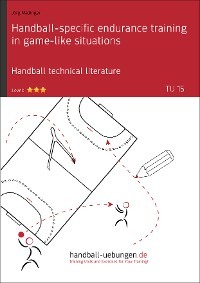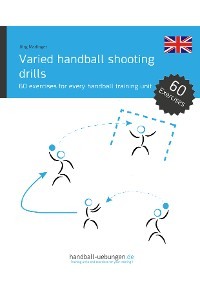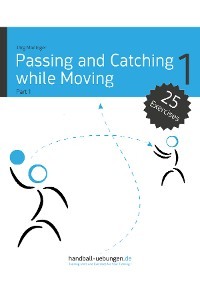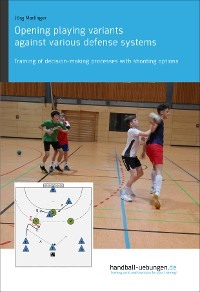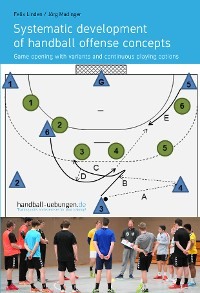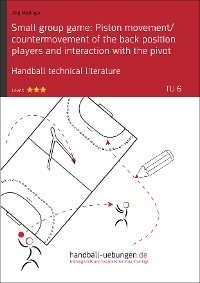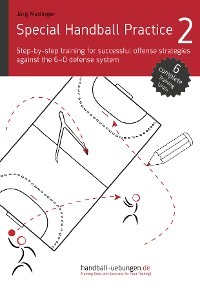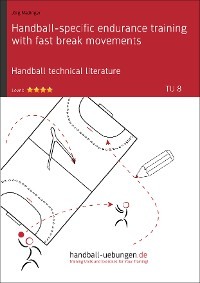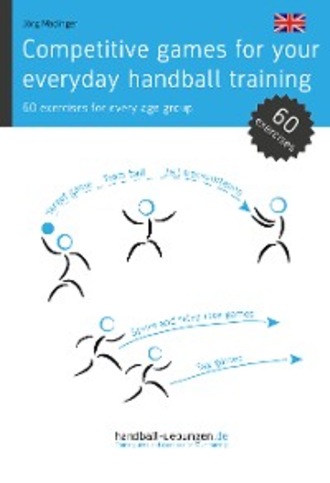
Полная версия
Competitive games for your everyday handball training

Introduction
Handball needs quick and correct decisions in each game situation. This can be trained playfully and diversely through handball-specific games. These 60 exercises are divided into seven categories and train the playing skills.
The book deals with the following subjects:
- Team ball variants
- Team play with different targets
- Tag games
- Sprint and relay race games
- Ball throwing and transportation games
- Games from other types of sports
- Complex closing game variants
The exercises are illustrated and described in an easy, comprehensible manner. They can be immediately integrated in every training unit. Various difficulty levels, additional notes, and possible variations allow for adjustment to each age group and group size.
Sample figure:
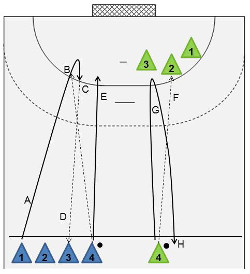
1st English edition released on 31 Mar 2017
German original edition released on 18 Sep 2015
Published by DV Concept
Editors, Design and Layout: Jörg Madinger, Elke Lackner
Proofreading and English translation: Nina-Maria Nahlenz
ISBN: 978-3-95641-185-4
The book and its contents are protected by copyright. No reprinting, photomechanical reproduction, storing or processing in electronic systems without the publisher’s written permission.
Key





















Category: Team ball variants
No. 1: Team ball: Basic version and variant
Minimum number of players: 6
Difficulty level:

Equipment required: 1 handball, 4 cones, playing field suitable for number of players
Setting:
- Define a suitable field with cones (suitable for the number of players and their level of performance).
- Make two teams.
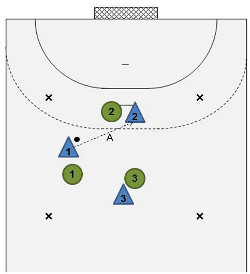
Course (figure 1):
- The team who has the ball tries to play a certain number of passes (5/10) while trying to keep the players of the defending team from touching the ball (A).
- If they manage to play the defined number of passes, they get a point and the other team gets the ball.
- The team who has the fewest points at the end must do a predefined exercise (2 accelerating runs, for example).
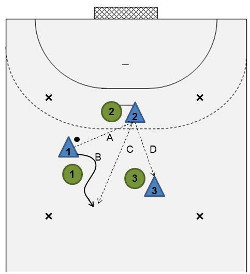
Variant (figure 2):
- The team only gets a point if the player (


- For this purpose,

- Passing to another teammate (

No. 2: Team ball with additional running exercises
Minimum number of players: 6
Difficulty level:

Equipment required: 1 handball, 4 cones, playing field suitable for number of players
Setting:
- Define a suitable field with cones (suitable for the number of players and their level of performance).
- Make two teams.
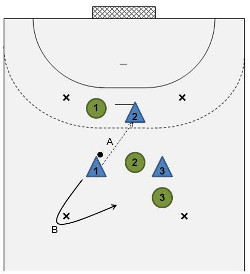
Course 1 (figure 1) (6-8 players):
- The teams play team ball in the playing field (see exercise no. 1).
- After each pass (A), the players must run around a cone first (B) before they may receive a pass again. If the team who has the ball manages to play 10 passes without the other team touching the ball, the defending players must do 10 quick jumping jacks, for example.
- Without dribbling.
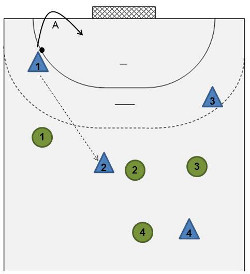
Course 2 (figure 2) (8 or more players):
- The players play on the entire half of the court.
- Following each pass,

- If the team who has the ball manages to play 10 passes without the other team touching the ball, the defending team must do 10 quick jumping jacks, for example.
- Without dribbling.
Additional exercises for the players who left the field after playing the pass before they are allowed to step back into the field and receive a pass again (exercises must be done outside of the field):
- 5 push-ups, 1 somersault on a mat, 5 straight jumps, for example.
No. 3: Team ball with moving 1
Minimum number of players: 8
Difficulty level:

Equipment required: 1 handball, 4 cones, playing field suitable for number of players
Setting:
- Divide the playing field into four smaller fields using cones (I to IV).
- Make two teams.
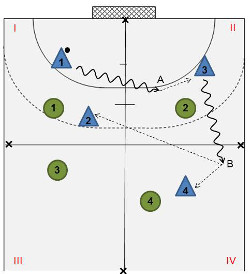
Course:
- The two teams play team ball against each other.
- The player holding the ball must dribble out of his field first (A and B) before he is allowed to play a pass.
Exercise/objective:
- The attacking players try to play 10 passes. If they succeed, the defending players must do a predefined exercise.
Variants:
- No return passes allowed (for larger groups).
- Jump shot passes.
- Passing with the non-throwing hand.
No. 4: Team ball with mats
Minimum number of players: 8
Difficulty level:

Equipment required: When playing 4-on-4, 6 mats required (2 more mats than players per team), 1 handball, ½ handball court or equivalent playing field
Setting:
- Put several gym mats on the floor of the playing field.
- Make two teams.
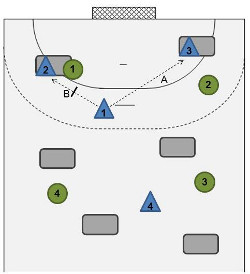
Course:
- The teams play team ball against each other.
- The players get a point, if they manage to play a pass to their teammate standing on the mat (A).
- They do not get the point, if a player of the other team touches the mat (B), but are allowed to continue.
- Dribbling is allowed.
Exercise/objective:
- The attacking players try to score 10 points. If they succeed, the defending players must do a predefined exercise.
- The players are not allowed to play passes from one mat to another mat; they must leave the mat first or play a pass to one of the players not standing on a mat.
Variants:
- Without dribbling.
- No return passes.
- Jump shot passes.
- Passing with the non-throwing hand.
No. 5: Team ball with hoops
Minimum number of players: 8
Difficulty level:

Equipment required: 1 handball, 2 more hoops than players per team, playing field suitable for number of players
Setting:
- Make two teams.
- Put the hoops on the floor of the playing field (two more hoops than players per team).
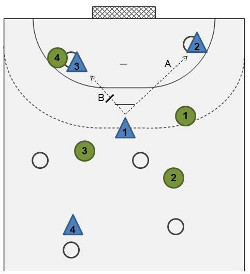
Course:
- Two teams play team ball in the playing field.
- The players score a point, if the player receiving the pass stands in a hoop with one foot (A).
- They do not get a point, if a player of the other team stands in the hoop as well (B).
Variants:
- The player must not only stand in the hoop, but also bounce the ball on the floor inside the hoop one time.


No. 6: Team ball with boxes
Minimum number of players: 8
Difficulty level:

Equipment required: 1-2 more boxes than players per team (in the example: 4 players and 5 boxes), 1 handball, playing field suitable for number of players
Setting:
- Make two teams.
- Put small vaulting boxes (at least one more than players per team) on the floor of the playing field.
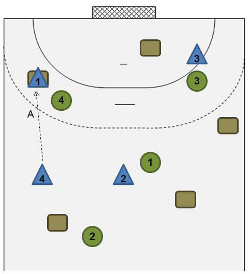
Course:
- The teams play team ball in the playing field.
- The players get a point, if they manage to play a pass to a teammate standing on a box.

Exercise/objective:
- The attacking players try to score 10 points. If they succeed, the defending players must do 10 push-ups, for example.
Variants:
- Without dribbling.
- Jump shot passes.
- The players must play a double pass with the player standing on the box (the return pass must be played to the player who played the initial pass). This is more challenging for the player receiving the return pass. After playing the pass, he must get into space immediately in order to get the ball. The game becomes much faster!


No. 7: Team ball with 4 targets
Minimum number of players: 8
Difficulty level:

Equipment required: 1 handball, 4 cones, 2 small vaulting boxes, playing field suitable for number of players
Setting:
- Put two cone goals and two small vaulting boxes (upside down) on the floor in the corners of the playing field.
- Make two teams.
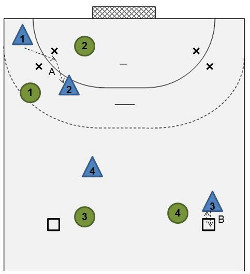
Course:
- The two teams play team ball against each other and try to score points by doing the following:
Either:
-

Or:
-

Each team defends one cone goal and one box.
Exercise/objective:
- The attacking players try to score 10 points. If they succeed, the defending players must do a predefined exercise.
- The players must adjust quickly, if a target is covered by an opponent.
Variants:
- Allow dribbling.
- No return passes allowed (for larger groups).
- Jump shot passes.
- Passing with the non-throwing hand.
- Do not assign the targets; the players can score points randomly.
- The players can only score a point, if they hit both “targets” (cone and box) one after another.
No. 8: Power team ball
Minimum number of players: 8
Difficulty level:

Equipment required: 8 cones, two playing fields suitable for number of players
Setting:
- Define two playing fields of similar size with cones.
- Make two teams.
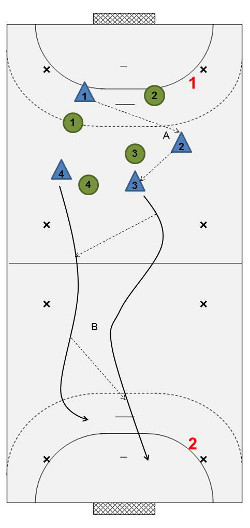
Course:
- Two teams play team ball against each other in the confined playing field (field 1), observing the following rules:
→ Each player (




→ Afterwards, the player must lay down the ball behind the line of cones in the opposite field (2) (B).
→ Now, there is a switch in ball possession.




→ If players manage to steal the ball, they start the course in the field in which they stole the ball.
Variant:
- Allow dribbling.


No. 9: Team ball on four side lines
Minimum number of players: 12
Difficulty level:


Equipment required: 1 handball, ½ playing field
Setting:
- Make 4 teams of at least 3 players.
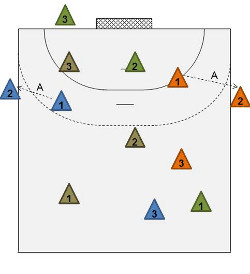
Course:
- The teams play team ball against each other.
- The players play towards one of the side lines; they score points by laying down the ball behind the line (A).
- Which team will play towards which side line will be figured out during the game.
- The players who manage to lay down the ball behind a free line “own” this line throughout the whole game.
- The players who laid down the ball must leave the ball there immediately for the other teams.
- A player of another team may now pick up the ball and start playing towards his team’s line.
- Dribbling is allowed.
Exercise/objective:
- The players must adjust quickly and fetch the ball swiftly in order to succeed again with their team. The individual tasks change permanently.
Variants:
- Jump shot passes.
- Passing with the non-throwing hand.
No. 10: Team ball with subsequent action
Minimum number of players: 10
Difficulty level:


Equipment required: 8 cones, 1 handball
Setting:
- Use cones to define several cone goals.
- Assign the numbers 1 to 4 to the side lines.
- Make two teams.
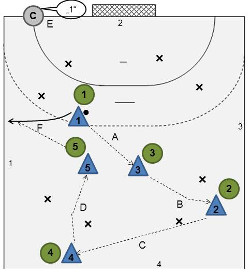
Course:
- The teams play against each other.
- By running and passing the ball in a well-coordinated manner (A), the team in ball possession tries to pass the ball 5 (7) times to a teammate by bouncing it through one of the cone goals (B or D).
- The players must attack a different cone goal each time (C). They are not allowed to bounce the ball through the same cone goal two times in a row.




